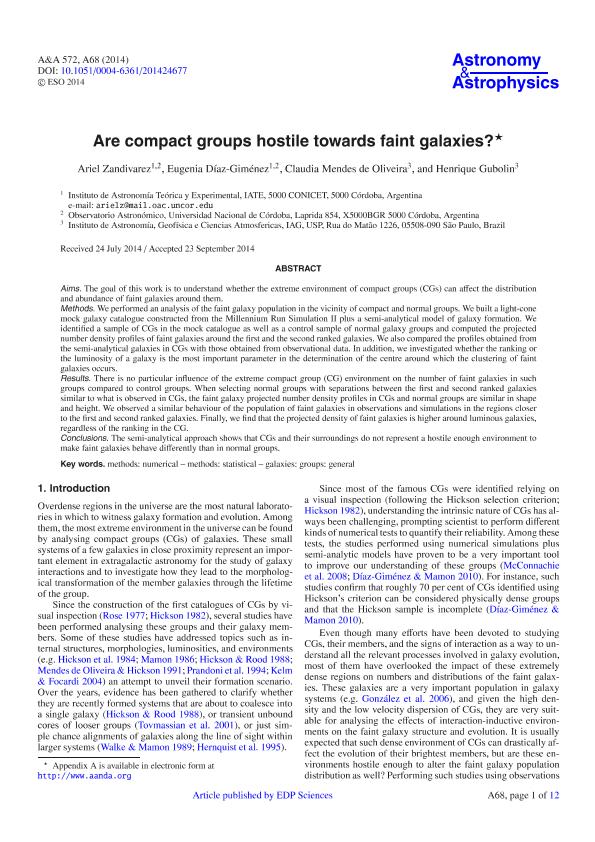Mostrar el registro sencillo del ítem
dc.contributor.author
Zandivarez, Arnaldo Ariel

dc.contributor.author
Diaz, Maria Eugenia

dc.contributor.author
Oliveira, Claudia Mendes de
dc.contributor.author
Gubolin, Henrique
dc.date.available
2018-01-04T21:18:26Z
dc.date.issued
2014-12
dc.identifier.citation
Oliveira, Claudia Mendes de; Diaz, Maria Eugenia; Zandivarez, Arnaldo Ariel; Gubolin, Henrique; Are compact groups hostile towards faint galaxies?; EDP Sciences; Astronomy and Astrophysics; 572; 12-2014; 68-80; A68
dc.identifier.issn
0004-6361
dc.identifier.uri
http://hdl.handle.net/11336/32375
dc.description.abstract
Aims: The goal of this work is to understand whether the extreme environment of compact groups (CGs) can affect the distribution and abundance of faint galaxies around them. Methods: We performed an analysis of the faint galaxy population in the vicinity of compact and normal groups. We built a light-cone mock galaxy catalogue constructed from the Millennium Run Simulation II plus a semi-analytical model of galaxy formation. We identified a sample of CGs in the mock catalogue as well as a control sample of normal galaxy groups and computed the projected number density profiles of faint galaxies around the first and the second ranked galaxies. We also compared the profiles obtained from the semi-analytical galaxies in CGs with those obtained from observational data. In addition, we investigated whether the ranking or the luminosity of a galaxy is the most important parameter in the determination of the centre around which the clustering of faint galaxies occurs. Results: There is no particular influence of the extreme compact group (CG) environment on the number of faint galaxies in such groups compared to control groups. When selecting normal groups with separations between the first and second ranked galaxies similar to what is observed in CGs, the faint galaxy projected number density profiles in CGs and normal groups are similar in shape and height. We observed a similar behaviour of the population of faint galaxies in observations and simulations in the regions closer to the first and second ranked galaxies. Finally, we find that the projected density of faint galaxies is higher around luminous galaxies, regardless of the ranking in the CG. Conclusions: The semi-analytical approach shows that CGs and their surroundings do not represent a hostile enough environment to make faint galaxies behave differently than in normal groups.
dc.format
application/pdf
dc.language.iso
eng
dc.publisher
EDP Sciences

dc.rights
info:eu-repo/semantics/openAccess
dc.rights.uri
https://creativecommons.org/licenses/by-nc-sa/2.5/ar/
dc.subject
Methods: Numerical
dc.subject
Methods: Statistical
dc.subject
Galaxies: Groups: General
dc.subject.classification
Astronomía

dc.subject.classification
Ciencias Físicas

dc.subject.classification
CIENCIAS NATURALES Y EXACTAS

dc.title
Are compact groups hostile towards faint galaxies?
dc.type
info:eu-repo/semantics/article
dc.type
info:ar-repo/semantics/artículo
dc.type
info:eu-repo/semantics/publishedVersion
dc.date.updated
2018-01-03T20:11:38Z
dc.journal.volume
572
dc.journal.pagination
68-80; A68
dc.journal.pais
Francia

dc.description.fil
Fil: Zandivarez, Arnaldo Ariel. Consejo Nacional de Investigaciones Científicas y Técnicas. Centro Científico Tecnológico Conicet - Córdoba. Instituto de Astronomia Teórica y Experimental. Universidad Nacional de Córdoba. Observatorio Astronómico de Córdoba. Instituto de Astronomia Teórica y Experimental; Argentina
dc.description.fil
Fil: Diaz, Maria Eugenia. Consejo Nacional de Investigaciones Científicas y Técnicas. Centro Científico Tecnológico Conicet - Córdoba. Instituto de Astronomia Teórica y Experimental. Universidad Nacional de Córdoba. Observatorio Astronómico de Córdoba. Instituto de Astronomia Teórica y Experimental; Argentina
dc.description.fil
Fil: Oliveira, Claudia Mendes de. Universidade do Sao Paulo. Instituto Astronomia, Geofisica e Ciencias Atmosfericas; Brasil
dc.description.fil
Fil: Gubolin, Henrique. Universidade do Sao Paulo. Instituto Astronomia, Geofisica e Ciencias Atmosfericas; Brasil
dc.journal.title
Astronomy and Astrophysics

dc.relation.alternativeid
info:eu-repo/semantics/altIdentifier/doi/http://dx.doi.org/10.1051/0004-6361/201424677
dc.relation.alternativeid
info:eu-repo/semantics/altIdentifier/url/https://www.aanda.org/articles/aa/abs/2014/12/aa24677-14/aa24677-14.html
Archivos asociados
